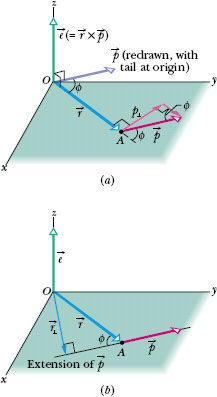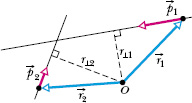Recall that the concept of linear momentum ![]() and the principle of conservation of linear momentum are extremely powerful tools. They allow us to predict the outcome of, say, a collision of two cars without knowing the details of the collision. Here we begin a discussion of the angular counterpart of
and the principle of conservation of linear momentum are extremely powerful tools. They allow us to predict the outcome of, say, a collision of two cars without knowing the details of the collision. Here we begin a discussion of the angular counterpart of ![]() , winding up in Section 11-11 with the angular counterpart of the conservation principle.
, winding up in Section 11-11 with the angular counterpart of the conservation principle.
Figure 11-12 shows a particle of mass m with linear momentum ![]() as it passes through point A in an xy plane. The angular momentum
as it passes through point A in an xy plane. The angular momentum ![]() of this particle with respect to the origin O is a vector quantity defined as
of this particle with respect to the origin O is a vector quantity defined as

where ![]() is the position vector of the particle with respect to O. As the particle moves relative to O in the direction of its momentum
is the position vector of the particle with respect to O. As the particle moves relative to O in the direction of its momentum ![]() , position vector
, position vector ![]() rotates around O. Note carefully that to have angular momentum about O, the particle does not itself have to rotate around O. Comparison of Eqs. 11-14 and 11-18 shows that angular momentum bears the same relation to linear momentum that torque does to force. The SI unit of angular momentum is the kilogram-meter-squared per second (kg · m2/s), equivalent to the joule-second (J · s).
rotates around O. Note carefully that to have angular momentum about O, the particle does not itself have to rotate around O. Comparison of Eqs. 11-14 and 11-18 shows that angular momentum bears the same relation to linear momentum that torque does to force. The SI unit of angular momentum is the kilogram-meter-squared per second (kg · m2/s), equivalent to the joule-second (J · s).
To find the direction of the angular momentum vector ![]() in Fig. 11-12, we slide the vector
in Fig. 11-12, we slide the vector ![]() until its tail is at the origin O. Then we use the right-hand rule for vector products, sweeping the fingers from
until its tail is at the origin O. Then we use the right-hand rule for vector products, sweeping the fingers from ![]() into
into ![]() . The outstretched thumb then shows that the direction of
. The outstretched thumb then shows that the direction of ![]() is in the positive direction of the z axis in Fig. 11-12. This positive direction is consistent with the counterclockwise rotation of position vector
is in the positive direction of the z axis in Fig. 11-12. This positive direction is consistent with the counterclockwise rotation of position vector ![]() about the z axis, as the particle moves. (A negative direction of
about the z axis, as the particle moves. (A negative direction of ![]() would be consistent with a clockwise rotation of
would be consistent with a clockwise rotation of ![]() about the z axis.)
about the z axis.)
To find the magnitude of ![]() , we use the general result of Eq. 3-27 to write
, we use the general result of Eq. 3-27 to write

Fig. 11-12 Defining angular momentum. A particle passing through point A has linear momentum ![]() , with the vector
, with the vector ![]() lying in an xy plane. The particle has angular momentum
lying in an xy plane. The particle has angular momentum ![]() with respect to the origin O. By the right-hand rule, the angular momentum vector points in the positive direction of z. (a) The magnitude of
with respect to the origin O. By the right-hand rule, the angular momentum vector points in the positive direction of z. (a) The magnitude of ![]() is given by
is given by ![]() . (b) The magnitude of
. (b) The magnitude of ![]() is also given by
is also given by ![]() .
.

where ![]() is the smaller angle between
is the smaller angle between ![]() and
and ![]() when these two vectors are tail to tail. From Fig. 11-12a, we see that Eq. 11-19 can be rewritten as
when these two vectors are tail to tail. From Fig. 11-12a, we see that Eq. 11-19 can be rewritten as

where p⊥ is the component of ![]() perpendicular to
perpendicular to ![]() and v⊥ is the component of
and v⊥ is the component of ![]() perpendicular to
perpendicular to ![]() . From Fig. 11-12b, we see that Eq. 11-19 can also be rewritten as
. From Fig. 11-12b, we see that Eq. 11-19 can also be rewritten as

where r⊥ is the perpendicular distance between O and the extension of ![]() .
.
Just as is true for torque, angular momentum has meaning only with respect to a specified origin. Moreover, if the particle in Fig. 11-12 did not lie in the xy plane, or if the linear momentum ![]() of the particle did not also lie in that plane, the angular momentum
of the particle did not also lie in that plane, the angular momentum ![]() would not be parallel to the z axis. The direction of the angular momentum vector is always perpendicular to the plane formed by the position and linear momentum vectors
would not be parallel to the z axis. The direction of the angular momentum vector is always perpendicular to the plane formed by the position and linear momentum vectors ![]() and
and ![]() .
.
![]() CHECK POINT 4 In part a of the figure, particles 1 and 2 move around point O in opposite directions, in circles with radii 2 m and 4 m. In part b, particles 3 and 4 travel in the same direction, along straight lines at perpendicular distances of 4 m and 2 m from point O. Particle 5 moves directly away from O. All five particles have the same mass and the same constant speed. (a) Rank the particles according to the magnitudes of their angular momentum about point O, greatest first. (b) Which particles have negative angular momentum about point O?
CHECK POINT 4 In part a of the figure, particles 1 and 2 move around point O in opposite directions, in circles with radii 2 m and 4 m. In part b, particles 3 and 4 travel in the same direction, along straight lines at perpendicular distances of 4 m and 2 m from point O. Particle 5 moves directly away from O. All five particles have the same mass and the same constant speed. (a) Rank the particles according to the magnitudes of their angular momentum about point O, greatest first. (b) Which particles have negative angular momentum about point O?

Figure 11-13 shows an overhead view of two particles moving at constant momentum along horizontal paths. Particle 1, with momentum magnitude p1 = 5.0 kg · m/s, has position vector ![]() and will pass 2.0 m from point O. Particle 2, with momentum magnitude p2 = 2.0 kg · m/s, has position vector
and will pass 2.0 m from point O. Particle 2, with momentum magnitude p2 = 2.0 kg · m/s, has position vector ![]() and will pass 4.0 m from point O. What are the magnitude and direction of the net angular momentum
and will pass 4.0 m from point O. What are the magnitude and direction of the net angular momentum ![]() about point O of the two-particle system?
about point O of the two-particle system?
Solution: The Key Idea here is that to find ![]() , we can first find the individual angular momenta
, we can first find the individual angular momenta ![]() 1 and
1 and ![]() 2 and then add them. To evaluate their magnitudes, we can use any one of Eqs. 11-18 through 11-21. However, Eq. 11-21 is easiest, because we are given the perpendicular distances r1⊥ (= 2.0 m) and r2⊥ (= 4.0 m) and the momentum magnitudes p1 and p2. We are not given all the values required for the variables in the other equations.
2 and then add them. To evaluate their magnitudes, we can use any one of Eqs. 11-18 through 11-21. However, Eq. 11-21 is easiest, because we are given the perpendicular distances r1⊥ (= 2.0 m) and r2⊥ (= 4.0 m) and the momentum magnitudes p1 and p2. We are not given all the values required for the variables in the other equations.
For particle 1, Eq. 11-21 yields
ℓ1 = r⊥1p1 = (2.0 m)(5.0 kg · m/s)
= 10 kg · m2/s.
To find the direction of vector ![]() , we use Eq. 11-18 and the right-hand rule for vector products. For
, we use Eq. 11-18 and the right-hand rule for vector products. For ![]() , the vector product is out of the page, perpendicular to the plane of Fig. 11-13. This is the positive direction, consistent with the counterclockwise rotation of the particle’s position vector
, the vector product is out of the page, perpendicular to the plane of Fig. 11-13. This is the positive direction, consistent with the counterclockwise rotation of the particle’s position vector ![]() around O as particle 1 moves. Thus, the angular momentum vector for particle 1 is
around O as particle 1 moves. Thus, the angular momentum vector for particle 1 is

Fig. 11-13 Two particles pass near point O.
ℓ1 = +10 kg · m2/s.
Similarly, the magnitude of ![]() 2 is
2 is
ℓ2 = r⊥2p2 = (4.0 m)(2.0 kg · m/s)
= 8.0 kg · m2/s,
and the vector product ![]() is into the page, which is the negative direction, consistent with the clockwise rotation of
is into the page, which is the negative direction, consistent with the clockwise rotation of ![]() around O as particle 2 moves. Thus, the angular momentum vector for particle 2 is
around O as particle 2 moves. Thus, the angular momentum vector for particle 2 is
ℓ2 = −8.0 kg · m2/s.
The net angular momentum for the two-particle system is then

The plus sign means that the system’s net angular momentum about point O is out of the page.
Leave a Reply